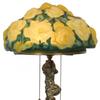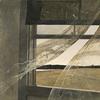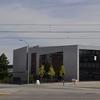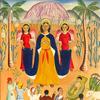Currier Museum of Art Acquires Mysterious Double-Sided Painting by Major 20th Century Artist
- MANCHESTER, New Hampshire
- /
- November 21, 2016
The Currier Museum of Art in Manchester, New Hampshire, has recently acquired at international auction an important and unusual early 20th century painting. The work by German artist Max Pechstein (1881-1955) is a rare example of a double-sided painting. Painted back-to-back on a single piece of canvas, the two images seem to form a unified narrative, as revealed by new research at the museum.
This new acquisition will be the centerpiece of a special exhibition that opens on November 25, 2016 at the Currier, called Paradise Lost: A Double-Sided Mystery by Max Pechstein. Despite its significance, the painting has never before been studied closely. It appears that the landscape on one side and the still life on the other are not independent works, but form two parts of a combined story. Kurt Sundstrom, curator at the Currier Museum, suggests that the landscape might be a depiction of the Garden of Eden, while the still life with a woman may show the Temptation of Eve. Together, the two sides form a modern retelling of a biblical story.
To set this major new acquisition in context, the exhibition includes works by Pechstein’s predecessors and contemporaries, including Paul Cezanne (1839-1906), Pablo Picasso (1881-1973), and others. The broad brush strokes in Pechstein’s still life are derived from Cezanne, while the angular, outlined surfaces are indebted to Picasso and early cubism. Most noteworthy, his mysterious female figure reveals his study of the primitivist work of Paul Gauguin (1848-1903). Pechstein, like Gauguin, travelled to the Pacific islands to seek places unspoiled by Western civilization. The exhibition will also feature German Expressionist prints from the Currier Museum’s collection.
Pechstein’s masterwork will be presented in a custom-made frame that will allow visitors to view both sides of the canvas for the first time, and to explore it in connection with other movements of modern art. The museum has been working to unravel the mystery of this double-sided painting, and the exhibition will suggest one solution to the puzzle. It will become clear that the landscape on one side and the still life on the other, which had been treated independently of each other, are in fact two elements of a single narrative.
A reading of Pechstein’s memoirs and a close examination of related paintings suggest that the landscape is a representation of the Garden of Eden. The opposite side, far from being a prosaic still life, depicts the temptation of Eve. Visitors to the exhibition will explore in greater depth the meaning of this interrelated narrative and how this painting foreshadowed events that would lead to the First World War (1914-19).
Max Pechstein was one of the first painters to be described as an Expressionist. He joined the German art group called Die Brücke, or The Bridge, in 1906. These artists created colorful, emotional images that were anything but naturalistic. He is also known for his extensive work as a printmaker.
In 1933, at the height of Pechstein’s popularity, Germany’s Nazi government designated him a “degenerate” artist because of his innovative, modern style. They ordered that 326 of his works be removed from public museums. Some of these works, along with many by his friends, were exhibited in the Degenerate Art exhibition held in Munich in 1937. Pechstein was also fired from his position as professor at the Berlin Academy. At the end of World War II in 1945, he was reinstated.
In the early 20th century, Europe was wracked by political crisis and a widespread feeling of apprehension. The rapid growth of industries and cities dismantled traditional ways of life. Artists reacted to this anxiety by developing an entirely new visual language that sought to express their sense of loss and fears for the future. Anxiety and anger were conveyed through works which depicted extreme emotional stress. This was matched by visual techniques including arbitrary colors, flattened perspective, and harsh simplification of form.











100x100_c.jpg)



